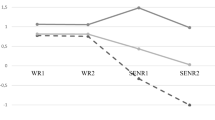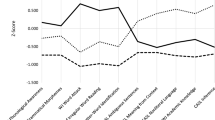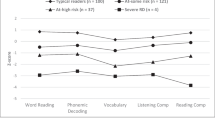Abstract
By using latent profile analysis eight stable and interpretable subgroups of readers were identified. The basis for subgrouping was different performance measures with four aspects of reading in focus: reading of continuous texts, reading of document texts, word reading and reading speed. Participants were 9-year-old Swedish students included in the International Association for the Evaluation of Educational Achievement (IEA) Reading Literacy Study in 1991 (n = 4,184) and in 2001 (n = 5,099). The eight subgroups were compared on different background variables, such as gender, language at home, and cultural and socioeconomic factors. It was concluded that latent profile analysis proved to be a feasible methodology. The even performance profiles of good and average readers imply that reading is a skill with a high degree of transfer and generality. Several subgroups of poor readers with more heterogeneous performance patterns could be identified. The three most stable subgroups proved to be comprised of high performers, poor comprehenders and dyslexic students.







Similar content being viewed by others
References
Aaron, P. G., Joshi, M., Gooden, R., & Bentum, K. (2008). Diagnosis and treatment of reading disabilities based on the component model of reading: An alternative to the discrepancy model of LD. Journal of Learning Disabilities, 41, 67–84.
Abu-Rabia, S., & Siegel, L. (2002). Reading, syntactic, orthographic, and working memory skills of bilingual Arabic-English speaking Canadian children. Journal of Psycholinguistic Research, 31, 661–678.
Balke, G. (1995, April). Decomposition of reading comprehension. Analysis of the IEA Reading Literacy tests. Paper Presented at the Annual Meeting of the American Educational Research Association, San Francisco, USA.
Bialystok, E. (1988). Levels of bilingualism and levels of linguistic awareness. Developmental psychology, 24, 560–567.
Bourdieu, P. (1997). The forms of capital. In A. H. Halsey, H. Lauder, P. Brown, & A. Stuart Wells (Eds.), Education, culture, economy and society (pp. 46–58). Oxford: Oxford University Press.
Castles, A., & Coltheart, M. (1993). Varieties of developmental dyslexia. Cognition, 47, 149–180.
Catts, H. W., Hogan, T. P., & Fey, M. (2003). Subgrouping poor readers on the basis of reading related abilities. Journal of Learning Disabilities, 36, 151–164.
Coleman, J. S. (1975). Methods and results in the IEA studies of effects of school and learning. Review of Educational Research, 45, 355–386.
Coleman, J., Campbell, E., Hobson, C., McPartland, J., Mood, A., Weinfield, F., et al. (1966). Equality of educational opportunity. Washington, DC: U.S. Government Printing Office.
Croll, P. (1986). Systematic classroom observation. London: The Falmer Press.
Da Fontoura, H., & Siegel, L. (1995). Reading, syntactic, and working memory skills of bilingual Portuguese-English Canadian children. Reading and Writing: An Interdisciplinary Journal, 7, 139–153.
Doehring, D., & Hoshko, I. (1977). Classification of reading problems by the Q-technique of factor analysis. Cortex, 13, 281–294.
Elley, W. B. (1992). How in the world do students read?. The Hague: The International Association for the Evaluation of Educational Achievement.
Elley, W. B. (Ed.). (1994). The IEA study of Reading Literacy: Achievement and instruction in thirty-two school systems. International studies in educational achievement. Great Britain, Exeter: Pergamon.
Everatt, J., Smythe, I., Adams, E., & Ocampo, D. (2000). Dyslexia screening measures and bilingualism. Dyslexia, 6, 42–56.
Fredriksson, U. (2002). Reading skills among students of immigrant origin in Stockholm. Stockholm: Institute of International Education.
Frederickson, N., & Frith, U. (1998). Identifying dyslexia in bilingual children: A phonological approach with inner London Sylheti speakers. Dyslexia, 4, 119–131.
Frith, U. (1997). Brain, mind and behaviour in dyslexia. In C. Hulme & M. Snowling (Eds.), Dyslexia. Biology, cognition and intervention (pp. 1–19). London: Whurr Publishers.
Frith, U. (1999). Paradoxes in the definition of dyslexia. Dyslexia, 5, 192–214.
Frith, U., Wimmer, H., & Landerl, K. (1998). Differences in phonological recoding in German and English speaking children. Scientific Studies of Reading, 2, 31–54.
Gough, P. (1995). The new literacy: Caveat emptor. Journal of Research in Reading, 18, 79–86.
Gough, P., & Tunmer, W. (1986). Decoding, reading, and reading disability. Remedial and Special Education, 7, 6–10.
Grigorenko, E. (2001). Developmental dyslexia: An update on genes, brains, and environments. Journal of Child Psychology and Psychiatry, 42, 91–125.
Gustafsson, J.-E. (1995, April). Alternative hierarchical models of reading achievement. Paper Presented at the Annual Meeting of the American Educational Research Association, San Francisco, USA.
Gustafsson, J.-E., & Rosén, M. (2003, August). The dimensional structure of reading assessment tasks in the IEA Reading Literacy Study 1991 and the progress in International Reading Literacy Study 2001. Paper Presented at the EARLI 10th Biennal Conference in Padova, Italy.
Gustafsson, J.-E., & Rosén, M. (2004). The IEA 10-Year trend Study of Reading Literacy: A multivariate reanalysis. Manuscript in preparation.
Gustafsson, J.-E., Rosén, M., & Myrberg, E. (2003). Förändringar i läskompetens 1991–2001. En jämförelse över tid och länder [Changes in competence of reading. A comparison over time and countries]. Sweden: Skolverket.
Gustafsson, J.-E., & Stahl, P-A. (2001). STREAMS User’s guide, Version 2.5 for Windows95/98/NT. Mölndal, Sweden: Multivariate Ware.
Høien, T., & Lundberg, I. (2000). Dyslexia. From theory to intervention. Dordrecht, NL: Kluwer.
Hoover, W., & Gough, P. (1990). The simple view of reading. Reading and Writing: An Interdisciplinary Journal, 2, 127–160.
Landerl, K. (2001). Word recognition deficits in German: More evidence from a representative sample. Dyslexia, 7, 183–196.
Lundberg, I. (1985). Longitudinal studies of reading and writing difficulties in Sweden. In G. E. McKinnon & T. G. Waller (Eds.), Reading research: Advances in theory and practice (pp. 65–105). New York: Academic Press.
Lundberg, I. (1999). Towards a sharper definition of dyslexia. In I. Lundberg, F. E. Tonnessen, & I. Austad (Eds.), Dyslexia. Advances in theory and practice (pp. 9–29). Dordrecht, NL: Kluwer.
Lundberg, I., & Olofsson, Å. (1981). Dyslexielevers sociala bakgrund (Social background of dyslexic students). Nordisk tidskrift för specialpedagogok, 59, 203–213.
Manis, F., Seidenberg, M., Doi, L., McBride-Chang, C., & Petersen, A. (1996). On the bases of two subtypes of developmental dyslexia. Cognition, 58, 157–195.
Miller Guron, L. (2004). First and second language rapid naming speed and word recognition automaticity. Manuscript submitted for publication.
Miller Guron, L., & Lundberg, I. (2003). Identifying dyslexia in multilingual students: Can phonological awareness be identified in the majority language?. Journal of research in Reading, 26, 69–82.
Morris, R. D., Stuebing, K. K., Fletcher, J. M., Shaywitz, S. E., Lyon, G. R., Shankweiler, D. P., et al. (1998). Subtypes of reading disability: Variability around a phonological core. Journal of Educational Psychology, 90, 347–373.
Muter, V., & Diethelm, K. (2001). The contribution of phonological skills and letter knowledge to early reading development in a multilingual population. Language learning, 51, 187–219.
Muthén, L. K., & Muthén, B. O. (2001). Mplus user’s guide (2nd ed.). Los Angeles, CA: Muthén & Muthén.
Nation, K., & Snowling, M. (1997). Assessing reading difficulties: The validity and utility of current measures of reading skill. British Journal of Educational Psychology, 67, 359–370.
Olson, R., Forsberg, H., & Wise, B. (1994). Genes, environment, and the development of orthographic skills. In V. W. Berninger (Ed.), The varieties of orthographic knowledge I: Theoretical and developmental issues (pp. 27–71). Dordrecht, The Netherlands: Kluwer.
Paulesu, E., Frith, U., Snowling, M., Gallagher, A., Morton, J., Frackowiak, R. S. J., et al. (1996). Is developmental dyslexia a disconnection syndrome? Evidence from PET scanning. Brain, 119, 143–157.
Ramus, F. (2004). The neural basis of reading acquisition. In M. S. Gazzaniga (Ed.), The cognitive neurosciences (3rd ed., pp. 815–824). Cambridge, MA: MIT Press.
Ramus, F. (2006). A neurological model of dyslexia and other domain-specific developmental disorders with an associated sensorimotor syndrome. In G. D. Rosen (Ed.), The dyslexic brain: New pathways in neuroscience discovery (pp. 75–101). Mahwah, NJ: Lawrence Erlbaum Associates.
Rapkin, B. D., & Luke, D. A. (1993). Cluster analysis in community research: Epistemology and practice. American Journal of Community Psychology, 21, 247–277.
Samuelsson, S., & Lundberg, I. (2003). The impact of environmental factors on components of reading and dyslexia. Annals of Dyslexia, 53, 201–217.
Satz, P., & Morris, R. (1981). Learning disability subtypes: A review. In F. J. Pirozzolo & M. C. Wittrock (Eds.), Neoropsychological and cognitive processes in reading. New York: Academic Press.
Snow, C., Burns, S., & Griffin, P. (1998). Preventing reading difficulties in young children. Washington, D.C.: National Academy Press.
Snowling, M. (2000). Dyslexia. Oxford: Blackwell Publishers Ltd.
Sprenger-Charolles, L., Colé, P., Lacert, P., & Serniclaes, W. (2000). On subtypes of developmental dyslexia: Evidence from processing time and accuracy scores. Canadian Journal of Experimental Psychology, 54, 87–103.
SPSS. (1999). SPSS Base 10.0, user’s guide. Chicago: SPSS Inc.
Stanovich, K. E. (1988). Explaining the differences between the dyslexic and the garden-variety poor reader: The phonological-core variable-difference model. Journal of Learning Disabilities, 21, 590–612.
Stanovich, K. E. (1991). Discrepancy definitions of reading disability: Has intelligence led us astray? Reading Research Quarterly, 26, 7–29.
Stanovich, K. E., & Siegel, L. S. (1994). Phenotypic performance profile of children with reading disabilities: A regression-based test of the phonological-core variable-difference model. Journal of Educational Psychology, 86, 24–53.
Stanovich, K. E., Siegel, L., & Gottardo, A. (1997). Converging evidence for phonological and surface subtypes of reading disability. Journal of Educational Psychology, 89, 114–127.
Svensson, I., & Jacobsson, C. (2005). How persistent are phonological difficulties? A longitudinal study of reading retarded children. Dyslexia, 12, 3–20.
Tierney, R. (1998). Literacy assessment reform: Shifting beliefs, principled possibilities, and emerging practices. Reading Teacher, 51, 374–390.
Wagemaker, H., Taube, K., Munck, I., Kontogiannopoulou-Polydorides, G., & Martin, M. (1996). Are girls better readers? Gender differences in reading literacy in 32 countries. Amsterdam: IEA.
Wilson, A. M., & Lesaux, N. K. (2001). Persistence of phonological processing deficits in college students with dyslexia who have age-appropriate reading skills. Journal of Learning Disabilities, 34, 394–400.
Wolff, U. (2009). Phonological and surface subtypes among dyslexic university students. International Journal of Disability, Development and Education, 56.
Wolf, M., & Bowers, P. G. (1999). The double-deficit hypothesis for the developmental dyslexias. Journal of Educational Psychology, 91, 415–438.
Wolf, M., Goldberg O’Rourke, A., Gidney, C., Lovett, M., Cirino, P., & Morris, R. (2002). The second deficit: An investigation of the independence of phonological and naming-speed deficits in developmental dyslexia. Reading and Writing: An Interdisciplinary Journal, 15, 43–72.
Wolff, U., & Lundberg, I. (2003). A technique for group screening of dyslexia among adults. Annals of Dyslexia, 53, 324–339.
Yang, Y. (2003). Measuring socio-economic status at individual and collective levels. A cross-country comparison (Gothenburg Studies in Educational Science, Vol. 193). Gothenburg: Acta Universitatis Gothenburgenis.
Yang, Y., & Gustafsson, J.-E. (2004). Measuring socioeconomic status at individual and collective levels. Educational Research and Evaluation, 10, 259–288.
Yelland, G. W., Pollard, J., & Mercuri, A. (1993). The metalinguistic benefits of limited contact with a second language. Applied psycholinguistics, 14, 423–444.
Acknowledgement
This research was a part of the SALS project (Studier Av Läsfärdigheten i Sverige) financed by the Swedish Research Council. I wish to thank Professor Jan-Eric Gustafsson and Professor Ingvar Lundberg for their guidance and helpful advice during varying stages of this work.
Author information
Authors and Affiliations
Corresponding author
Rights and permissions
About this article
Cite this article
Wolff, U. Subgrouping of readers based on performance measures: a latent profile analysis. Read Writ 23, 209–238 (2010). https://doi.org/10.1007/s11145-008-9160-8
Received:
Accepted:
Published:
Issue Date:
DOI: https://doi.org/10.1007/s11145-008-9160-8




